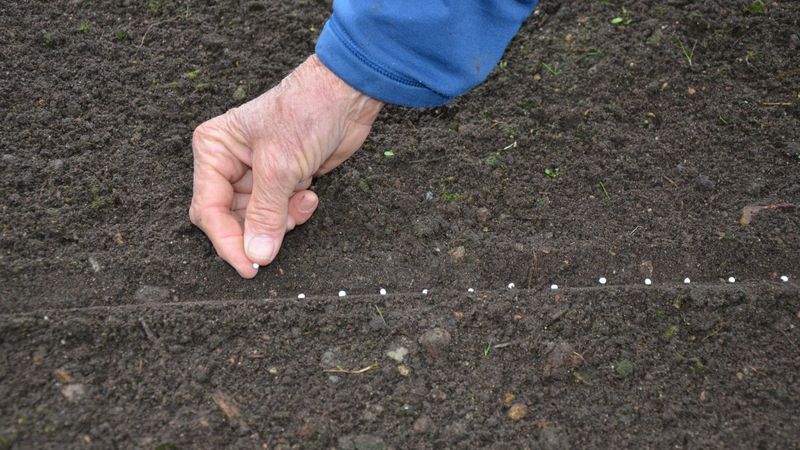Step-by-step instructions for growing carrots from scratch
Carrots are one of the main products of our menu, containing a large amount of carotene, mineral salts, essential oils, vitamins and minerals. It is simply impossible to replace it with anything else.
The crop is grown everywhere, adhering to the standard technology for preparing planting material and soil for sowing, the procedure for thinning and hilling beds, moderate watering, weeding and loosening.
Variety selection
Carrot varieties are divided into early, mid-season and late. There are hybrids that have taken the best characteristics from their “parents”. They are characterized by high yield and disease resistance. There are varieties with the usual orange, exotic purple and even white coloring.
The choice is varied and can satisfy the needs of every gardener.
The table contains the best varieties and hybrids of fruitful and sweet carrots.
| Name | Ripening period, days | Weight, g | Length, cm | Coloring | Form |
| Nantes-4 | 80-120 | 50-60 | 12-16 | Orange | Cylindrical |
| Dunyasha | 70-90 | 60-80 | 14-16 | Orange | Cylindrical |
| Emperor | 120-135 | 90-100 | 25-30 | Bright orange | Cone-shaped, pointed |
| Queen of Autumn | 120-130 | 85-230 | 18-23 | Orange | Cone-shaped |
| Red giant | 120-140 | 80-140 | 25-35 | Red-orange | Cone-shaped |
| Baltimore F1 | 95-100 | 65-140 | 20-25 | Rich orange | Cylindrical |
| Purple Elixir F1 | 65-70 | 60-100 | 18-20 | Purple-brown skin, orange flesh | Cylindrical |
| White sugar F1 | 90-110 | 70-110 | 20-23 | White | Cylindrical |
The photo shows the carrot variety Purple Elixir F1.

Carrot planting dates
Sowing carrots depends on the desired timing of harvest and its purpose.To obtain early carrots, spring sowing work is carried out from the second ten days of April to the beginning of May. Root crops are collected in bunches from late June to July. In August, the harvest has reached technical ripeness.
Summer sowing is carried out from mid-May to early June. The harvested crop is suitable for winter storage.
To obtain juicy young carrots in the fall, sowing is done in mid-July.
Pre-winter sowing occurs from October 20 to November 15. Root crops are harvested in early summer. For planting, use areas where the snow melts early and the soil is sandy and light. When sowing carrots before winter, the seeds are disinfected in a solution of potassium permanganate, dried and sown immediately. In the spring they will absorb moisture and sprout naturally.
Reference. With late sowing - before the 20th of June - the growing season does not coincide with the beginning of carrot fly activity in May, which allows you to grow a high-quality product.
Crop rotation rules
An important rule for successful carrot cultivation is compliance with crop rotation. The best crop predecessors: tomatoes, onions, cucumbers, potatoes, cabbage, garlic.
It is not recommended to plant carrots after dill, parsley, celery, and parsnips due to the risk of infection with diseases common to these crops.
Seed preparation

The shell of carrot seeds contains a large amount of essential oils that impair their germination. The stronger the smell, the higher the concentration of aromatic substances.
The easiest way to increase germination is to thoroughly rinse the seeds in clean water with the addition of potassium permanganate, growth stimulator Zircon or Epin.
There are several other ways of pre-sowing preparation.
The first method involves soaking the seeds in water heated to a temperature of +50...+60°C for 15 minutes.Seeds that float to the surface are thrown away. Those left at the bottom are suitable for sowing. They are dried until flowable in the open air. This preparation guarantees germination within 4-5 days in favorable weather.
The second method takes a little more time. The seeds are soaked in an aqueous solution of Epin for 2-3 hours, then placed in a thick linen bag and buried in the ground to the depth of a spade bayonet. After 1-2 weeks, the seeds are dug up and mixed with 1 tbsp. l. river sand and a pinch of lettuce or radish seeds. After this treatment, the seeds swell and sprout. This increases germination several times and reduces the number of planting thinnings. Radishes and lettuce grow faster than carrots, which helps to mark the area with crops and carry out surface loosening.
The third method allows you to 100% optimize the cultivation of carrots in the open air.
Stages of seed preparation:
- Soak in damp gauze for 2-3 days and rinse regularly in clean water (1-2 times a day).
- Cook a paste from flour and water: 2-3 tbsp. l. Brew 100-150 ml of boiling water of baking flour and mix thoroughly.
- Apply the paste onto a piece of toilet paper in drops at intervals of 2 cm.
- Place 1-2 seeds in each drop.
- Allow the strip to air dry for 15 minutes.
Next, the tapes are placed in wet furrows to a depth of 2 cm, covered with soil and compacted. Water the top with clean, settled water. The paper will gradually decompose and the seeds will sprout. This method of pre-sowing preparation reduces the frequency of thinning, the paste prevents the seeds from scattering throughout the bed, and it becomes possible to calculate the approximate amount of harvest.
Reference. Seeds of carrot hybrids are processed in production, so they do not require additional preparation. These seeds are covered with a colored shell.
Soils

Loamy soil is best for growing carrots.. In clogged, heavy soil, seeds take a long time to germinate, so in such conditions it is recommended to build boxes with suitable soil. In the fall, the soil is dug into them, and humus and compost are added in the spring.
Sandy soil is too loose and does not retain the moisture that carrots need so much. Therefore, here too, the best solution would be to install a box and annually replace the turf mixed with compost.
Choose a plot for carrots in a sunny place. The soil should be nutritious with a neutral pH = 6.5-7 units.
Acidic soil is deoxidized with ash, slaked lime or dolomite flour - 400-500 g per 1 m². Then the area is dug up.
Fertilizers are applied in the spring. Any organic compositions, except manure, and complex mineral supplements are suitable. For example, per 1 m² add 10 liters of peat, 5 liters of humus, 30-40 g of superphosphate.
Sowing technology

The selected area is loosened to a depth of 10-15 cm, then leveled and long furrows 5 cm wide and 2 cm deep are formed. The row spacing is 25-30 cm.
To obtain uniform shoots, the seeds are planted to the same depth.
Experienced gardeners advise making a hard substrate. To do this, the furrows are leveled and compacted with timber. Then they spill with water and sow the seeds at intervals of 1.5-2 cm. To facilitate the process, 1 tbsp. l. planting material is mixed with a glass of river sand, the resulting mixture is divided into 3 equal parts and sown each 1 m².
The seeds are covered with loose sifted soil or peat mixed with sand for better contact with the ground and to ensure an influx of moisture.
The beds are not watered after sowing so that the seeds do not move into the deep layers of the soil. To retain moisture, the area is covered with a thick film, which is removed after germination.
How to care for plantings
How to grow a healthy carrot crop? The main secret to successful cultivation is proper care. The most crucial moment is the germination of planting material, so it is important to create favorable conditions for this.
After watering, a dense crust forms on the surface of the soil, which is carefully loosened, trying not to touch the seeds, and then tender sprouts. To prevent its occurrence, the beds are mulched with peat.
The best time for loosening is immediately after rain. If there is no rain for a long time, the carrots are first watered and then they begin to loosen.
After the appearance of 2 true leaves, the crops are thinned out, leaving a gap of 3-4 cm. The procedure is repeated after 2-3 weeks, leaving a distance of 4-5 cm. First, the soil is watered, then the excess plants are pulled out. The greens are pulled up without loosening, so as not to tear off the main root of the remaining carrots, otherwise lateral roots will appear, forming a “horned” root crop. Thinning is carried out in the evening so as not to attract insects to the site that are greedy for the carrot aroma. Holes in the ground are filled and compacted.
Hilling is carried out as the root crops grow, because the top of the carrots becomes bare and turns green, forming solanine, which imparts bitterness. The procedure is carried out in cloudy weather or in the evening.
The culture prefers moderate watering.The plant forms root crops at the end of the growing season and does not tolerate excess moisture well - cracks appear on the root crops.
During drought, plantings are watered 3 times a week, in moderate weather - 1-2 times every 7 days. Young plants should not be filled with water; 4 liters per 1 m² is enough. With subsequent growth, the amount of water increases. In the middle of growth, carrots are watered once a week, using 8-10 liters of water per 1 m².
Provided that a sufficient amount of fertilizer is applied before sowing, it is possible to grow an excellent harvest without additional fertilizing. If there is a lack of nutritional components, plantings are fertilized 2-3 times over the entire period:
- The first fertilizing is carried out 30 days after full germination: 25 g of “Nitrophoska” per 10 liters of water.
- The second fertilizing is applied 15 days after the first: 1 liter of wood ash per 10 liters of water (combined with watering).
- III foliar feeding is carried out in early August: 10 g of boric acid per 10 liters of water.
Disease and pest control

The carrot fly is the main pest of carrots.. You can grow a crop in one place for several years in a row without problems and suddenly find twisted tops and larvae in the root crops.
To combat the pest, onions, marigolds, cilantro, and garlic are sown nearby. The plants have a strong smell, which repels flies.
The most effective way to prevent the spread of the pest is to mulch the beds with agrofibre or peat or sawdust in a layer of up to 5 cm. The main thing is to prevent the fly from getting into the ground where it lays eggs. It is recommended to constantly update the mulch layer.
If infection cannot be avoided, the tops are sprayed with the chemicals Actellik or Inta-vir.
Carrots are practically not susceptible to infectious diseases.Alternaria blight, or “blackleg”, occasionally occurs due to violations of agricultural practices - sowing seeds without prior disinfection, untimely harvesting of weeds. Signs of the disease: leaves darken at the edges and curl, dark, dry rot develops in the roots. For prevention, the beds are sprayed with a 1% solution of Bordeaux mixture.
Nuances and difficulties of growing
Carrots are demanding on conditions and care. She prefers fertile and at the same time loose soil with good aeration, from which weeds are promptly removed.
In the open ground

When growing in open ground, it is important to choose and prepare the site correctly. The best place is considered to be where manure was applied 1-2 years before planting. Carrots respond to fresh manure with ugly, branchy and tasteless roots.
A poor quality harvest is obtained when:
- applying chlorine-containing fertilizers;
- the presence of plant residues in the soil and an excessive amount of small stones;
- excess moisture in the soil - root crops grow “hairy”, with excessively lush tops, and crack;
- lack of moisture - root vegetables produce lateral roots, the flesh becomes coarser;
- excess nitrogen - carrots branch strongly;
- violation of seedling thinning technology.
In the greenhouse
Growing carrots in a greenhouse has several advantages:
- vegetables ripen faster than in the garden;
- it is easier to control the amount of nutrients in the soil;
- planting care is kept to a minimum;
- the risk of infection by viruses and fungi, and insect attacks is reduced.
Year-round planting is possible in heated greenhouses. In ordinary simple designs, when sown in early April, the harvest is harvested in May.
For planting, varieties with early ripening are selected.The soil is dug up, loosened, and debris and weeds are removed. On the site, even rows 2 cm deep are formed with an interval of 20-25 cm.
The rules of care are the same as for growing in open ground.
Reference. Seeds and soil are disinfected before sowing due to the difficulty of processing plantings in a greenhouse.
In different regions
The rules for carrot farming are the same for all growing regions, but planting dates vary:
- in the middle zone (Moscow region), sowing work is carried out in late April - early May;
- in the Urals, North-West (Leningrad region), in Siberia - in May;
- in the southern regions - in the second ten days of March - early April.
Reproduction

Carrots are a biennial plant that reproduces by seeds. They can only be obtained from varietal carrots.
After harvesting and sorting, the largest and healthiest root crops are selected. The tops are cut off, leaving 2-3 cm from the head. Seeds are stored in the cellar separately from other vegetables. Planting is done in the spring, when the threat of frost has passed.
The beds are fertilized with compost and loosened, then holes are formed and each is watered with warm, clean water. After the liquid is absorbed, the root crop is placed in the hole, leaving the top at ground level.
The beds are watered and mulched with peat or sawdust. Further agricultural technology is standard for the crop.
After 60 days, a stem with a peduncle is formed. The dark beige color of the umbrella indicates that the seeds are ready for collection. The umbrellas are cut off and hung to dry, wrapped in gauze so that the seeds do not fall off. Next, the dry umbrellas are pulled with your hands, the seeds are poured onto cloth or paper and dried in the open air.
Harvest and storage
The harvest is harvested in several stages:
- Grown root crops at the stage of milky ripeness can be pulled out of the soil selectively.This unscheduled thinning provides the remaining specimens in the ground with more space for growth, nutrition and moisture.
- The harvest depends on the variety. Early carrots ripen in July, mid-season carrots in August, late carrots in the second half of September - the first half of October.
It is not advisable to rush into harvesting, since root crops gain mass until the second ten days of September. However, it is not recommended to be late - frozen carrots are poorly stored and rot.

From light sandy loam soil, root crops are pulled out by the tops. On dense soil you cannot do without a shovel. Excess soil is shaken off, vegetables are sorted: whole ones are sent for storage, damaged ones are put into processing, sick ones are thrown away.
For root crops selected for winter storage, the tops are cut down to the head. Then they are dried under a canopy for 4-6 days and placed in wooden or plastic boxes in layers, sprinkled with wet river sand or covered with moss.
Advice. Sprinkle carrots with crushed chalk or onion skins to prevent rotting.
There is another original way to store carrots - glazing. The clay is diluted with water to a thick sour cream, root vegetables are dipped into it and placed on wire racks to dry. This shell retains moisture inside the root crop. The optimal storage temperature is 0…+2°C. The storage must be dry.
Conclusion
The technology for cultivating carrots is simple, but requires compliance with a number of rules. It is important to carry out pre-sowing preparation of seeds without a colored shell or collected by hand to increase germination and protective powers. The soil should be light and nutritious, with neutral acidity.
The agricultural technology of the crop includes twice thinning the plantings, hilling the beds, moderate watering, removing weeds, loosening the soil crust and mulching the beds.